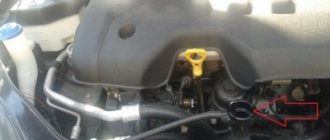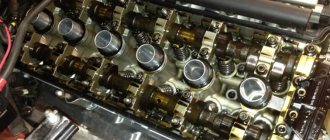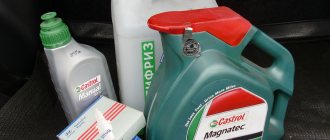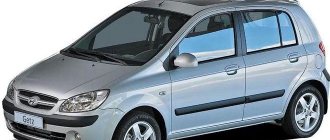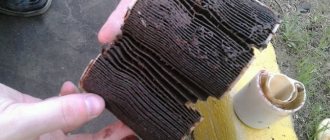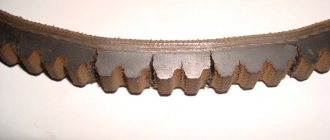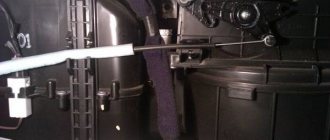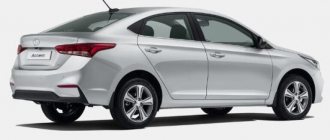Antifreeze for Hyundai (Accent, Sonata, Elantra, Solaris, Tussan, Creta) and KIA (Sid, Sportage, Spectra, Rio) cars has the same article number, manufacturer and the same composition. From the factory, these vehicles are filled with green coolant, made on the basis of ethylene glycol. It has the specifications of Hyundai-Kia MS 591–08, Korean KSM 2142 and Japan JIS K 2234. The filling capacity on each vehicle is different, depending on the manufacturer's recommendations. In Russia (at the St. Petersburg plant), an analogue of CoolStream A-110 is used instead. The specifications required for use in the cooling system are fully met by four brands of antifreeze available on the Russian market and CIS countries.
Stages of replacing the coolant Hyundai Accent
Since there is no drain plug on the engine, it is best to replace it with a complete flush of the cooling system. This will allow you to completely flush out the old antifreeze from the system and replace it with new one.
The best option for replacement would be to have a hole or overpass for more convenient access to the drain holes. Instructions for replacing the coolant will be useful for owners of the following Hyundai models:
- Hyundai Accent Restyling;
- Hyundai Accent Tagaz;
- Hyundai Verna;
- Hyundai Excel;
- Hyundai Pony.
Popular engines are petrol with a volume of 1.5 and 1.3 liters, as well as a diesel version with a 1.5 liter engine. There are also models with other displacements, but more often they were sold in other markets.
Coolant drain
All work should be carried out when the engine has cooled to 50°C or lower, so there is time for preparatory work. It is necessary to remove the engine protection, as well as the protective plastic, which is secured with 5 10mm head bolts, as well as 2 plastic pistons.
Next we move on to the main procedure:
- We find a plastic drain plug at the bottom of the radiator and unscrew it, having previously placed a container under this place into which the old antifreeze will drain (Fig. 1).
Fig. 1 Drain plug on the radiator Open the radiator plug to speed up the draining process (Fig. 2).
Fig.2 Radiator cap and expansion tank
- We remove the expansion tank for flushing and draining, since sediment often forms at its bottom. Which can sometimes only be removed mechanically, for example using a brush.
- Since there is no drain plug on the block head, we will drain it from the hose that goes from the thermostat to the pump. Removing the clamp with pliers is not convenient at all. Therefore, we select the correct key, unclench the clamp and tighten the pipe (Fig. 3).
Fig.3 Unclamp the clamp using a keyIn this way, we managed to completely drain the antifreeze from the Hyundai Accent, so we can collect everything and put it in its place. After which you can proceed to the next stage of replacement.
Flushing the cooling system
Before flushing, we check that all the pipes are in place, and that the drain valve is closed, and proceed directly to the procedure itself:
- Fill the radiator with distilled water to the top and close the lid, also fill the expansion tank halfway.
We start the car and wait until it warms up completely, until about the second time the fan turns on. In this case, you can periodically add gas.
- We turn off the car, wait until the engine cools down, and drain the water.
- We repeat the procedure until the water after rinsing is clear.
Usually clear water comes out after 2-5 runs. Each case is individual and depends on many factors.
After a well-carried out flush, the antifreeze on our Accent will fully perform its function until the next service replacement. If this procedure is not followed, the service life may be sharply reduced, since plaque and decomposed additives of the old coolant remain in the system.
Filling without air pockets
If the replacement is carried out with a complete flushing of the system, it is recommended to use a concentrate as a new fluid. Since distilled water remains in the system, in a volume of 1-1.5 liters. The concentrate must be diluted taking into account this volume.
Now we begin to pour new antifreeze into the radiator to the level of the bypass tube, as well as to the middle of the expansion tank. After this, close the covers and start the engine. We wait until it warms up completely, sometimes increasing the speed.
That's it, now we wait for the engine to cool down, check the fluid level in the radiator and tank. If necessary, make gravy. Fill the tank to the letter F.
With this approach, no air lock should form in the system. But if it does appear and the engine overheats because of this, you need to perform the following steps. We put the car on a hill so that the front is raised up.
We start the engine, warm it up with a constant increase in speed to 2.5-3 thousand. When doing this, we look at the temperature readings; we must not allow the engine to overheat. Then we turn off the engine and open the radiator cap a little so that it does not come out of gear, but the air can escape.
Usually after this you can get rid of the air lock. But sometimes this procedure must be repeated 2-3 times.
Cooling system Hyundai Accent (Hyundai Accent)
The cooling system is liquid, closed type, with forced circulation, and includes an engine cooling jacket, a radiator with an electric fan, an expansion tank, a thermostat and a coolant pump.
The system is filled with coolant through the radiator neck.
The circulation of liquid through the cooling jacket of the block and cylinder head is ensured by a coolant pump, after which it passes through the thermostat to the radiator, where it gives off heat to the surrounding air.
The movement of liquid through the engine cooling jacket and the radiator forms a large circulation circle, and the movement of liquid through the engine cooling jacket, bypassing the radiator, forms a small circulation circle.
The amount of liquid passing through the radiator of the cooling system is automatically controlled by a thermostat. The throttle assembly heating unit (see “Power system”, page 59) and the heater radiator are also connected to the cooling system.
Liquid circulates through them constantly and does not depend on the position of the thermostat valves. On vehicles with automatic transmission, part of the coolant is used to cool the automatic transmission.
Coolant pump
driven from the crankshaft pulley by a poly V-belt. The pump assembly is replaced when there is noise from the rotation of the bearing or when the impeller rotates tightly with the drive belt removed, there is large radial play of the pump shaft, or when a coolant leak occurs from
There is an inspection hole in the coolant pump housing
The thermostat is located in a housing attached to the cylinder head in the area of the 4th cylinder. When the engine is cold, the main thermostat valve blocks the flow of fluid to the radiator. Thus, the liquid, bypassing the radiator, circulates only in a small circle - through the bypass channel of the thermostat, the liquid from the cooling jacket enters the pump.
At a temperature of 82 °C, the thermostat valves begin to move, allowing fluid flow into the radiator and closing the bypass channel. At a temperature of 95 ° C, the main valve opens completely and the bypass valve closes, and almost all the fluid circulates through the engine radiator.
In this case, regardless of the position of the thermostat valves, the liquid always circulates through the heater radiator and the throttle body heating unit.
The radiator of the cooling system consists of two horizontal plastic tanks connected by aluminum tubes with cooling plates. The liquid enters the radiator through the upper pipe and is discharged through the lower. In the lower tank there is a drain hole closed with a plug.
Thermostat: 1 - air release valve; 2 - main valve; 3 - bypass valve
Radiator: 1 - filler hole; 2 - supply pipe; 3—eyes for fastening the electric fan; 4 — drain plug; 5 - outlet pipe
The radiator filler plug is equipped with inlet and outlet valves. The exhaust valve maintains increased (compared to atmospheric) pressure in the system when the engine is hot.
The pressure at which the exhaust valve opens is 0.9 bar. Due to this, the boiling point of the liquid increases and steam losses are reduced.
Excess pressure is released into a steam exhaust hose connected to the expansion tank.
The intake valve opens when the pressure in the system decreases relative to atmospheric pressure (on a cooling engine).
Radiator cap: 1 - inlet valve; 2 - exhaust valve
The electric fan is located behind the radiator in a casing. As the coolant temperature rises, the electric fan is turned on at the command of the electronic engine control unit.
A coolant temperature sensor is screwed into the left rear part of the cylinder head.
(see “Engine management system”, p. 70), which provides information to the temperature indicator in the instrument cluster and the electronic control unit.
The expansion tank is made of translucent plastic, which allows you to visually monitor the coolant level.
On the wall of the expansion tank there are marks F (maximum) and L (minimum), between which the liquid level should be. The radiator steam removal hose and a hose connected to the atmosphere are connected to the fittings in the tank lid.
Expansion tank
REPLACING THERMOSTAT
Drain the liquid from the cooling system (see “Replacing the coolant,” page 33). Remove the air filter (see “Removing the resonator, air filter housing and air duct with intake noise muffler”, p. 68).
Using a 12mm socket, unscrew the four bolts securing the thermostat housing cover (the upper and lower bolts also secure the wire holders).
Remove the thermostat housing cover without disconnecting the hoses from it.
Remove the cover gasket.
Remove the thermostat from the housing.
The thermostat flange bears its marking and the temperature at which the main valve begins to open.
To check the thermostat, lower it into a container of boiling water. The rod should begin to move, the main valve should open. This will indicate that the thermostat is working properly. We replace the faulty thermostat. Install the thermostat in reverse order. At the same time, we draw attention to the fact...
...that the thermostat can only be installed in one position (the protrusion on the thermostat must fit into the groove on the body).
Replacement frequency, what antifreeze to fill
Based on the operating instructions, as well as the manufacturer’s recommendations, replacing antifreeze on a Hyundai Accent Tagaz must be carried out once every 40,000 km.
After this period, basic functions deteriorate sharply. Protective and anti-corrosion additives stop working. Car enthusiasts use coolant standards G12 or G11 for replacement, guided by their knowledge, as well as the advice of friends. But the manufacturer recommends using original antifreeze for Hyundai Accent.
In Russia you can find Hyundai Long Life Coolant and Crown LLC A-110 for sale. They are both original antifreezes that can be used in cars of this brand. The first is produced in Korea, and the second has a country of origin of the Russian Federation.
There are also analogues, for example CoolStream A-110 from the description, which you can find out that it is poured from the factory into cars of this brand. Another analogue of RAVENOL HJC Hybrid Japanese Coolant, which also meets the tolerances.
The choice of which coolant to use remains with the car enthusiast, and there is plenty to choose from.
How much antifreeze is in the cooling system, volume table
| Model | Engine capacity | How many liters of antifreeze are in the system | Original liquid / analogues |
| Hyundai Accent | gasoline 1.6 | 6.3 | Hyundai Long Life Coolant |
| Hyundai Accent Tagaz | gasoline 1.5 | 6.3 | Crown LLC A-110 |
| gasoline 1.4 | 6.0 | CoolStream A-110 | |
| gasoline 1.3 | 6.0 | RAVENOL HJC Hybrid Japanese Coolant | |
| diesel 1.5 | 5.5 |
Video “Coolant boiled on Hyundai Accent”
This video demonstrates what can happen if the coolant is replaced on a Hyundai Accent at the wrong time or incorrectly.
In this article, we tried to describe in detail and clearly the process of replacing the coolant, but if you still have questions, leave a comment below.
Antifreeze for Hyundai (Accent, Sonata, Elantra, Solaris, Tussan, Creta) and KIA (Sid, Sportage, Spectra, Rio) cars has the same article number, manufacturer and the same composition. From the factory, these vehicles are filled with green coolant, made on the basis of ethylene glycol. It has the specifications of Hyundai-Kia MS 591-08, Korean KSM 2142 and Japan JIS K 2234. The filling capacity on each car is different, depending on the manufacturer's recommendations. In Russia (at the St. Petersburg plant), an analogue of CoolStream A-110 is used instead. The specifications required for use in the cooling system are fully met by four brands of antifreeze available on the Russian market and CIS countries.
Leaks and problems
Over time, your car needs to pay close attention to the pipes and hoses. They may begin to dry out and crack. What causes a leak to form, the worst thing is when it happens on the road, where you can’t get to a service center or a spare parts store.
The radiator filler cap is considered a consumable and therefore must be changed periodically. Because due to a soured bypass valve, the pressure in the system may increase, which will lead to a leak in the cooling system at a weak point.
Rarely does anyone pay attention to these little things, but they are the ones that can lead to problems with the cooling system.
Source
Signs that antifreeze needs to be replaced
Let us highlight several symptoms that indicate that the cooling system is filled with deteriorating liquid:
Precipitate appears in the system. It can be observed directly in the expansion tank. If you are repairing the system, pay attention to whether there is sediment in the lines and pipes. The fact that there is sediment in the system manifests itself clearly, as a rule, at low air temperatures - the engine warms up worse.
It is recommended to fill with high quality liquid. If you want to improve the efficiency of the system, then follow this single point. If the car’s engine is quite worn out, then you can also fill it with domestic antifreeze (Antifreeze). In fact, of course, even vodka is antifreeze. Antifreeze is a domestic analogue of non-freezing liquids for cooling systems. It is best to fill new engines with red antifreeze class G-12. It is based on ethylene glycol.
What antifreeze to pour into Hyundai: TOP 5 manufacturers
When thinking about what kind of antifreeze is best to pour into a Hyundai, many car enthusiasts are interested in Russian raw materials. Because the domestic product has a lower cost, and the quality is quite good. For example, CoolStream Optima. What other Russian-made antifreeze is popular among car enthusiasts?
We present to you a list of the most commonly used coolants for Hyundai, compiled in accordance with a survey of specialists from auto repair shops and their clients:
- FELIX Carbox -40. Carboxylate liquid containing special additives against the formation of bubbles, corrosion and premature wear of elements. Perhaps this antifreeze is one of the best on the domestic market. Produces coolant "Tosol-Sintez". The company carried out a series of tests and improved the quality of the composition to European standards. VAG tolerance index: G-12+, temperature range from -40 °C to +110 °C. Price – approximately 700 rubles. It is necessary to change the fluid after 250,000 km.
- NORD Red. . The coolant is made on the basis of ethylene glycol and contains high-tech additives. Temperature range from -40 °C to +112 °C. It can be used for five years, but sediment may form much earlier. Price from 500 to 800 rubles.
- LUKOIL Red G12. A carboxylate type of coolant that can be poured into a Hyundai. No special flaws were found. Price from 550 to 800 rubles. Suitable for very low temperatures. It cools the engine perfectly, keeps heat exchange normal, and uses additives evenly. You don't have to change it for five years.
- AGA Z40. Antifreeze of excellent quality from a domestic manufacturer. The liquid is produced by the AGA Trading House concern. Deliveries are made both in Russia and abroad. This fluid is suitable for turbocharged cars and high-performance engines. Temperature range from -40 °C to +112 °C, however, with a sharp temperature change, crystallization is possible. Properties are maintained for five years. Price range from 650 to 750 rubles.
- SINTEC LUX G12. It is another representative of coolant with a carboxylate base. Suitable for old Soviet and modern expensive cars. Produces. This is an excellent high-quality antifreeze, which, in addition to performing basic tasks, protects the system from deposits and helps clean it. May not be replaced for five years. The cost is about 600 rubles.
Replacing antifreeze with your own hands
You can replace the refrigerant in a garage, we will talk about this below.
Tools and materials
To change the fluid you will need:
How to drain?
First, we drain the consumables from the cooling system:
- Drive the car into a garage with a pit or onto an overpass. It is important that the Hyundai Accent is located on a flat surface.
- Open the hood of the car and unscrew the plug on the heat exchanger. Remove it and set it aside.
- Locate the coolant expansion tank in the engine compartment. Unscrew the lid on it.
- Find the pipe connected to the heat exchanger, then place a container under it into which the used antifreeze will be drained.
- Carefully unscrew the plug located on the radiator unit a few turns using a wrench. This will allow you to drain the refrigerant from the cooling system. There will be traces of leaks in the area of the drain hole; they should be wiped with a rag.
- Screw the drain plug into place.
Flushing the system
To properly change consumables, the cooling system must be flushed:
- For cleaning, you can use special antifreeze or distilled water. Fill the cooling system with clean distillate through the expansion tank and screw on the cap. Water must be added until its level rises to the steam outlet line.
- Start the engine and warm it up to operating temperature. When the engine is completely warmed up, you will hear the fan turn on.
- Stop the power unit and perform the drain procedure again.
- Assess the quality of the fluid drained from the cooling system. If there are traces of rust and deposits in the water and it is far from clear, then the washing procedure should be repeated again. Cleaning is carried out until perfectly clean water comes out of the system when drained. To flush the system, only distilled water is allowed.
- Remove the expansion tank and wash the inside of it to remove dirt.
The Diman and cars channel, using the example of a Hyundai Getz car, offers to familiarize yourself with the process of replacing the refrigerant and flushing the cooling system. In the case of Accent, the process will be performed similarly.
How to fill?
To fill the refrigerant, do the following:
- Tighten the drain plug.
- Slowly pour new antifreeze into the radiator neck. The liquid is poured until its level rises to the steam outlet line.
- Start the power unit and wait until it warms up, this will be indicated by the start of the cooling fan.
- Look at the refrigerant level in the expansion tank. If it begins to fall, this indicates that air pockets are coming out of the cooling system. When the level drops in the radiator device, add consumables a little at a time. In this case, you can compress the pipes connected to it, this will remove air from the lines.
- Wait a few more minutes and check the refrigerant level. The addition procedure can be repeated up to 6 times until air pockets leave the system.
- Tighten the plug on the radiator device.
- Perform a test drive and check the level again. If necessary, add refrigerant to the system. The liquid is poured until it reaches level “F” or between the MIN and MAX marks on the expansion tank.
Why is there an overconsumption of antifreeze?
Several common reasons why antifreeze is overused:
The engine block has a constant volume, but at sub-zero temperatures this value of the liquid decreases. Therefore, it is necessary to top up occasionally.
When do you need to change antifreeze on a Hyundai?
According to manufacturers' recommendations, most Hyundais (Accent, Sonata, Elantra, Solaris, Tucson, Creta) and KIA (Ceed, Sportage, Spectra, Rio) need to be replaced once every 10 years, or every 120 thousand km. But many experienced drivers agree that this is too long a period, and recommend changing it at least every 2 years, or 30 thousand km. To top up, you can use distilled water or ready-made diluted antifreeze (not concentrate). Water is usually added when the car is used intensively in the hot season.
Having opened the radiator cap, check the fluid level and top up if necessary (see “Replacing the coolant”). If it is necessary to add fluid to the system when the engine is warm, stop the engine.
Lifting the cap of the expansion tank by the tongue...
Remove it from the neck of the tank.
Add coolant to the tank, slightly below the “F” mark.
Coolant is poisonous.
Remove liquid that gets on engine parts or paintwork with a rag. Close the expansion tank with a lid.
If the fluid level in the reservoir is constantly decreasing, then there is most likely a leak in the system. In this case, it is necessary to check the tightness of the cooling system and eliminate the malfunction (see “Cooling system", page 82).
CHANGING COOLANT
When the engine is warmed up to operating temperature, the liquid in the cooling system is under pressure. To avoid burns, do not remove the radiator cap until the engine has cooled.
It is more convenient to replace the coolant when the car is installed on an inspection ditch or x-tank.
Remove the mudguard (see “Removing the mudguard", p. 143).
Rotate 90° counterclockwise...
We place a wide container with a volume of at least 6 liters under the drain hole made in the middle part of the lower radiator tank.
Unscrew the drain plug...
...and drain the coolant.
Moving the radiator supply hose to the side, we compress the ends of the clamp with pliers...
...remove the hose going to the coolant pump from the thermostat bypass pipe.
Having lowered the hose, drain the remaining coolant from it into a substitute container. We secure the hose to the pipe with a clamp and tighten the radiator drain plug. We remove the expansion tank, drain the coolant from it and install the tank in place (see “Removing the expansion tank", p. 83). We check the reliability of connections of all hoses of the cooling system.
Fill the radiator with coolant to the bottom edge of its neck...
And close the radiator cap. Pour liquid into the expansion tank.
We start the engine and warm it up to operating temperature. With the engine running, vigorously compress the cooling system hoses several times in turn. This will help the fluid fill the system and force air out of it. As the coolant level in the expansion tank drops, we bring it to normal. At
Changing the coolant on a Hyundai Accent yourself is not difficult. The car owner needs to allocate 3-4 hours for this procedure and follow the recommendations outlined below.
Antifreeze in Hyundai: what is filled from the manufacturer
In all configurations of the above-mentioned cars, the same antifreeze is always poured - green (do not confuse it with G11). There are slight differences only depending on the country of manufacture of the car.
Choice of antifreeze.
For cars manufactured in Russia, antifreeze is produced by order of Mobis Parts CIS LLC. The article number for this liquid is R9000AC001Н. This is a white liter bottle with the Hyundai or Kia emblem and the inscription Crown LLC A-110 antifreeze belongs to the phosphate-carboxylate class. Manufactured using the technologies of the Korean company Kukdong. This liquid contains, in addition to ethylene glycol, demineralized water and a special concentrate AC-110. Often, this antifreeze is purchased for refilling. There is no need to pre-dilute it with distilled water.
There is also the same liquid, only under the article number R9000AC001K. According to the catalog, it is used for KIA cars (this is indicated by the last letter K in the article). Both in composition and volume, both antifreezes are completely identical. Coolants are based on ethylene glycol, since Kia, just like Hyundai, has an aluminum radiator. Both comply with Hyundai/Kia specification MS591-08 and JIS K 2234. There is only a slight difference in price.
The original coolant for Hyundai and KIA, produced outside of Russia - Hyundai/Kia Long Life Coolant (concentrate) has article number 0710000200 (2 l) or 0710000400 (4 l). Manufacturer: KUKDONG JEYEN COMPANY LTD. This antifreeze is based on phosphate ethylene glycol and contains a minimum of amines, borates, silicates and nitrites, but belongs to the silicate class. Typically, the packaging of this product indicates a shelf life of 2 years (Coolant 2yr). But at the same time, the manufacturer recommends replacing antifreeze on Hyundai once every 10 years. These disagreements are due to the fact that during long-term storage of this liquid, sediment may form at the bottom of the container.
A type of antifreeze.
Since this South Korean antifreeze is supplied as a concentrate, it must be diluted with distilled water before use. It is advisable to dilute 1 to 1. In such proportions, a lower temperature of −37 ° C is achieved, and if you take 60 parts versus 40 water, then all of −52 degrees (in warm regions where the temperature does not drop below −26 ° C, they use inverse proportion). At other ratios, the lower operating temperature also changes. As a rule, such a coolant is purchased when the coolant is completely replaced.
What will you need for replacement?
So, now in more detail about how to replace antifreeze on a Hyundai Accent with your own hands. To carry out the work you need to purchase:
Concentrated antifreeze based on ethylene glycol - these work great in aluminum engines. The volume of liquid is no more than 3 liters.
The procedure is simple, but it takes three hours, or even more. First you need to perform the following manipulations:
- Remove the expansion tank by unscrewing the two mounting bolts.
- Pour out the old fluid and clean the inside.
- Reinstall the tank.
- You can drain the liquid from all pipes. But there is little point in this, just disturb the clamps. And dismantling the pipes is very problematic.
What is antifreeze and how to choose it
So, everyone knows that coolant remains in the car around the clock and all year round. In other words, when your car is not in use, antifreeze still has an effect on the parts of the vehicle. With the wrong coolant, it is easy to get a damaged cooling system: antifreeze can destroy the structure of the material and aggravate corrosion formations. During the trip, the “harmful” composition can foam and intensify the process of formation and further collapse of bubbles in the liquid.
We have already talked more than once about the types of coolant, its composition, and the additives used. Therefore, today we’ll talk about how to buy coolant correctly.
So:
- Buy ingredients of the appropriate level.
- Listen to the advice of car manufacturers, they will help you make the right choice.
- Focus on the permissible liquid temperature values.
- Make a purchase of coolant in stores that are trusted by car enthusiasts.
- Try not to combine liquids of different compositions without a serious reason. If this happens, then try to quickly change the mixture to a higher quality coolant.
When determining what antifreeze to pour into a Hyundai car, most people look at the color of the coolant. The factory fluid has a red tint. For example, ZERO Long Life or CoolElf Auto Supra. For Fords, they mainly produce purple-colored coolant Ford SUPER PLUS Premium. You can find orange (ACDelco DexCool Longlife, Texaco XLC DexCool, Motorcraft®Specialty Orange Engine Coolant, Havoline XLC) and pink (GM Longlife) antifreeze.
Color is an unofficial designation of coolant; there are no patterns in this matter. The most common red color is used for carboxylate compounds based on ethylene glycol (G12, G12+ and G12++). The purple tint is used for the same carboxylate coolant only based on propylene glycol (G13, G13+), which has an increased environmental class and a longer service life - about 10 years.
At the same time, the manufacturer has every right to give his product the color he likes. For example, the older G11 has both red and orange tints. In this regard, it will be a mistake to focus on the color of the coolant when purchasing.
All about replacing refrigerant
Before proceeding directly to the process of replacing antifreeze on a Hyundai Accent, you need to understand that the volume on each Accent engine is different, so you need to prepare a container measuring from 7 to 10 liters. We purchase the antifreeze itself and begin the replacement process.
- The first step is to drain the antifreeze.
Changing the coolant in a Hyundai Accent
A modern car is a rather complex technical device that needs to be carefully monitored if you want the car to function properly. All systems require periodic minor repairs. Such operations include replacing Hyundai Accent antifreeze.
How to change the fluid
Antifreeze
is a special fluid necessary to cool engine parts, thereby protecting them from excessive heat. Its presence in the car is necessary in the same way as the presence of brake fluid, since without it the cooling system and the car as a whole will not function.
You can change it either on your own or seek help from specialists at a car service center. If you have certain skills in working with mechanics, then performing all the procedures yourself will not be so difficult
.
Nuances
It is recommended to change the coolant every 4 years or upon reaching 45 thousand km. It all depends on what comes first. Give preference only to high-quality antifreeze so that you do not end up having to send the entire car for repairs.
To replace antifreeze in a Hyundai Accent, you need to know some details. This machine model is designed so that the process of changing the coolant is slightly different from the standard procedure
. But there is nothing scary or very difficult about this.
- Make sure that the car is on a flat, horizontal surface.
- Antifreeze is poured directly through the radiator, due to the fact that there is no drain plug on the tank. This is the difficulty mentioned above.
- First, we drain the old composition from the system. To do this, use containers of the required volume. If necessary, clean the system and filters.
- Having completed everything written above, you can begin to fill in new antifreeze. It is a mixture of coolant and distilled water. The proportions depend on the car itself, the temperature outside and, accordingly, the time of year.
- The oil product is filled to the required level, and after that the tank and radiator are closed.
Engine flushing
All work must be carried out only on a cooled engine! Now you need to flush the engine. And don't forget that the better you do this, the longer your engine will last. Perform the following manipulations:
- It is necessary to completely drain the liquid from the main radiator. There is a small black plug at the bottom right - you just need to unscrew it a little. In this case, the liquid will gradually pour out. To speed up the process, you need to unscrew the plug on the expansion tank. But you need to do this carefully - the liquid will begin to splash in all directions.
- After closing the stopper, you need to fill the upper neck with distilled water to the brim and close the lid.
- Set the heater knob to the maximum position (hottest air) and start the engine.
- Wait 15 minutes, the engine should idle until the fan turns on. If the fan does not turn on for a long time, you can increase the crankshaft speed by pulling the throttle cable.
- Turn off the engine and wait until the antifreeze cools down.
- Drain the liquid through the radiator cap.
Now all that remains is to repeat the washing procedure several times. Enough is enough when clear liquid without a tint begins to come out of the radiator.
How to change coolant
The difficulty of changing the coolant on a Hyundai Accent is that the coolant can only be drained through the radiator, because there is no drain plug on the tank. Replace only when the engine has completely cooled down.
How to drain
- The vehicle must be installed on a horizontal surface.
- It is necessary to lift the hood and unscrew the heat exchanger plug. Then remove it and put it next to it.
- Unscrew and remove the plug from the filler hole of the expansion tank.
- We place a container under the heat exchanger tap hose to drain the coolant.
- Be sure to wipe away possible coolant leaks near the drain hole.
- We tighten the drain plug.
- We flush the cooling system.
- Pour clean water into the coolant reservoir hole.
- Pour until the refrigerant level rises to the steam pipe.
- We turn on the engine and wait until the electric fan turns on.
- We turn off the engine and drain the water.
- This procedure can be repeated several times until clean water begins to drain.
How to fill
To ensure that there are no air pockets in the cooling system, it is necessary to tighten the radiator hoses while filling it.
Replacement of the cooling system for other Hyundai categories
In cars of other Hyundai categories, the method of replacing coolant is practically the same. To change antifreeze on a Hyundai Solaris or Hyundai Getz, you can follow the above recommendations; the procedure is carried out according to the same algorithm. On Hyundai Verna, replacing antifreeze is also similar to the procedure described.
Car enthusiasts who are interested in replacing Accent Drive2 antifreeze can follow the algorithm proposed above, however, minor differences are still present. The differences between Accent Drive2 and other Hyundai models are in the location of the tank, radiator and drain holes.
To maintain normal engine temperature conditions on a Hyundai Accent, also known as TagAZ, it is necessary to periodically change the coolant. This simple operation can be easily done with your own hands if you strictly follow the instructions and perform the necessary actions.
